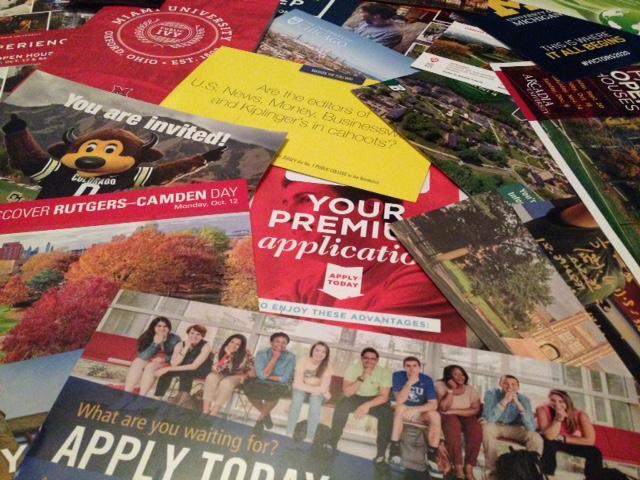The stress-free (ha!) guide to applying to colleges
After years of being overwhelmed by college options, seniors are about to finally take the plunge and apply to college (File photo: 2015)
September 29, 2015
Well, seniors, it’s finally here. The moment you’ve worked and wished for, stressed and lost sleep over; the moment you’ve used as motivation through endless hours of homework and the moment that, for many, has been presented as the only postsecondary option. Yes, seniors, the time has finally come for you to apply to college.
Don’t worry: you and your family have been preparing for this your entire life. In fact, your parents or grandparents have probably been saving up for your college education since the moment you came home from the hospital, a two-day-old newborn baby with unlimited potential for involvement in Harvard-impressing extracurricular activities. If this is not the case, and your parents spent their income in your early years on diapers, clothes, and food instead of extensive tutoring services or a $200,000 college fund, well, I’m sorry to tell you, but your dream of attending a nationally ranked university without incurring massive, crushing, life-long debt is most likely over. But have no fear: a quick google search brings up a wealth of information on the college admissions process, the most reliable of which comes from anonymous users on internet forums. But since you probably have fifteen essays to write for the ten schools you’re applying to, I’ve saved you time and compiled all of the best college application advice into one convenient article. You’re welcome, seniors.*
*Results may vary.
Step one: research colleges and decide where to apply
For most of you, this process probably started late in your sophomore year or towards the beginning of your junior year. After spending countless hours sorting through college mail and googling the admissions requirements for a certain school, you have probably, by now, come to the conclusion that the majority of schools either don’t have your major, cost too much money, are too far away from home, are too close to home, are too big, too small, too much of a party school, not enough of a party school, too hard to get in to, too easy to get in to, or any combination of the above. But eventually, you will find a few schools that you have deemed anywhere from “dream school” to “I guess I’d go there.”
Step two: Visit your top schools
The only thing more stressful than researching schools is actually visiting them. If a college is close enough to Lansdale that you can take a day trip there, buckle your seatbelt (literally) and prepare to endure a long car ride with your parents, during which they will ask you dozens of questions regarding every aspect of the school and expect you to know the answer (of course, this probably isn’t any different than any other day in your house in the past year). And if you want to go farther away, then it looks like you’re stuck staying overnight in a hotel room with your parents while every little detail of the trip is stressed and argued over between every family member multiple times (side note: I love you, mom and dad). Finally, you will arrive on campus for a few hours of information session and campus tour fun. Upon your arrival at the admissions office, you will be the directed toward the best dining hall on campus, which you probably won’t be able to afford to eat in should you choose to attend the college. After lunch, you will head towards the hour-long information session led by a middle-aged woman who spends five minutes talking about “the value of an *insert name of college here* education before flipping to the Powerpoint slide showing the school’s shockingly high tuition. Following this mind-numbing lecture filled with information you already know from your Google searches, you will then be led around campus by a backwards-walking tour guide who will point out the fancy, billion-dollar research buildings that you will never be allowed to set foot in as an undergrad but will, nonetheless, pay for with your shockingly high tuition. Repeat this routine for all or most of your schools, and finally it’s time for the best part of applying to colleges: actually applying to colleges.
Step three: Fill out basic info on applications
Luckily for you, the Common App is there so you don’t have to fill out your basic information multiple times. Unluckily for you, at least one of your schools will not be on the Common App, therefore essentially defeating its purpose. Oh well: as you become an adult, paperwork is part of life; might as well learn now. Trudge through filling out every tiny detail about exciting things such as your parent’s education history (each completed dropdown list revealing three more dropdown lists) and you’re well on your way to making your college dreams a reality.
Step four: Write your essay(s)
This is your chance to really stand out to admissions officers. Make sure you show, don’t tell, an interesting side of your personality that you’re pretty sure is inside you somewhere, even though you’ve been thinking about this essay for months and still have no idea what to write about. Write your essay the night before it is due as an assignment for English class and then spend the next week telling yourself it sucks, but don’t actually change anything, because deep down, even though you already wrote your essay, you still don’t know what to write about.
Step five: Send in your transcript, SAT scores, teacher recommendations, counselor/school reports, and application fees
There’s nothing quite like putting your application (and, therefore, your future) in somebody else’s hands. And there’s nothing better than paying $70 just to have the admissions office deign to skim your application before throwing it in the appropriately marked pile. Aren’t these the same schools that were begging you to pay attention to them in your email inbox just a few weeks ago? And why do schools even have application fees, anyway? Is $40,000 a year in tuition not enough to pay the moderately paid people who will be skimming my application? Why do I have to pay $11.25 (per college) to send my SAT scores when I already paid $54.50 (per sitting) to take the SAT? Who comes up with the prices for these things, anyway? And how is the College Board considered a nonprofit? How many teacher recommendations do I actually need? Why did Panera get rid of their tomato-mozzarella panini and replace it with an inferior whole grain version? Why is college so expensive before you even commit to attend anywhere (another fee?) And why do I have so many questions and so few answers about this whole process?
Step six: Wait
I haven’t gotten to this part yet, but I’m pretty sure it’s going to be awful.
Step seven: Sit back and watch your acceptances and scholarship offers roll in, weigh all of your options, finally commit to a college, and feel four years of hard work pay off as you prepare for the next step of your life
I haven’t gotten to this part yet, but I’m pretty sure it’s going to be awesome.




















Bill Travers NPHS Guidance • Sep 29, 2015 at 1:34 pm
Nice Article on the “College Search” but try to keep it REAL. The average debt for Pa high school students after securing their undergraduate degree is between approx. $18,000 – $27,000. Parents may have debt also but the total undergraduate debt figure you used is ‘scare’ information.